The National Register of Historic Places (NRHP) is the United States federal government's official list of districts, sites, buildings, structures and objects deemed worthy of preservation for their historical significance. A property listed in the National Register, or located within a National Register Historic District, may qualify for tax incentives derived from the total value of expenses incurred in preserving the property.

The Ennis House is a residential dwelling in the Los Feliz neighborhood of Los Angeles, California, United States, south of Griffith Park. The home was designed by Frank Lloyd Wright for Charles and Mabel Ennis in 1923 and was built in 1924.

George Rogers Clark National Historical Park, located in Vincennes, Indiana, on the banks of the Wabash River at what is believed to be the site of Fort Sackville, is a United States National Historical Park. President Calvin Coolidge authorized a classical memorial and President Franklin D. Roosevelt dedicated the completed structure in 1936.

The Colorado Chautauqua, located in Boulder, Colorado, United States, and started in 1898, is the only Chautauqua west of the Mississippi River still continuing in unbroken operation since the heyday of the Chautauqua Movement in the 1920s. It is one of the few such continuously operating Chautauquas remaining in the United States, and was designated a National Historic Landmark in 2006. According to its governing body, the Colorado Chautauqua Association, it is also unique in that it is the only year-round Chautauqua.

Fountain of Time, or simply Time, is a sculpture by Lorado Taft, measuring 126 feet 10 inches (38.66 m) in length, situated at the western edge of the Midway Plaisance within Washington Park in Chicago, Illinois, in the United States. This location is in the Washington Park community area on Chicago's South Side. Inspired by Henry Austin Dobson's poem "Paradox of Time", and with its 100 figures passing before Father Time, the work was created as a monument to the first 100 years of peace between the United States and the United Kingdom, resulting from the Treaty of Ghent in 1814. Although the fountain's water began running in 1920, the sculpture was not dedicated to the city until 1922. The sculpture is a contributing structure to the Washington Park United States Registered Historic District, which is a National Register of Historic Places listing.

The Robinson High School Auditorium-Gymnasium, also known as the RHS Gym was a historic gymnasium located on the campus of Robinson High School in Robinson, Illinois. The gym was constructed in 1939 using funds granted by the Public Works Administration. The Art Deco building featured fluted columns around its entrance, glass-block windows at the entrance and east and west sides, and curved metal awnings. Both high school athletic events and public events were held in the building, as Robinson had no other large public space suitable for hosting community events at the time.
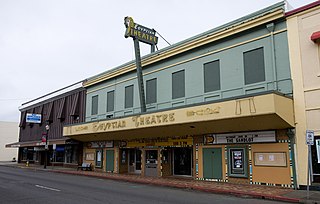
The Egyptian Theatre is a historic movie theatre in Coos Bay, Oregon, United States. It was originally built as a garage, and was converted to a theatre in 1925. With a seating capacity of 770, the theatre is an example of the Egyptian Theatre style of Egyptian Revival architecture that was popular in the early 20th century in the U.S., especially following the 1922 discovery of the tomb of King Tut. The building was listed on the U.S. National Register of Historic Places on May 24, 2010. In fact it was announced as the featured listing in the National Park Service's weekly list of June 4, 2010.

The Chicago Avenue Pumping Station is a historic district contributing property in the Old Chicago Water Tower District landmark district. It is located on Michigan Avenue along the Magnificent Mile shopping district in the Near North Side community area of Chicago, Illinois. It is on the east side of Michigan Avenue opposite the Chicago Water Tower.
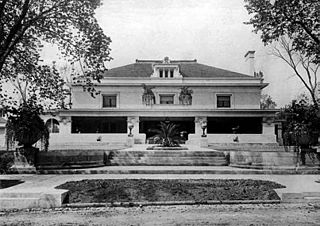
Pleasant Home, also known as the John Farson House, is a historic home located in the Chicago suburb of Oak Park, Illinois, United States. The large, Prairie style mansion was designed by architect George Washington Maher and completed in 1897. The house was added to the U.S. National Register of Historic Places on June 19, 1972. Exactly 24 years later, in 1996, it was declared a National Historic Landmark by the United States Department of the Interior.

The Lewis Miller Cottage is a historic house at Whitfield and Vincent Avenues, on the grounds of the Chautauqua Institute in Chautauqua, New York. Built in 1874, it was the residence of Lewis Miller, founder and leader of the Chautauqua movement. It was named a National Historic Landmark in 1965 for its association with Miller, and is included in the larger Chautauqua Institution Historic District, also a National Historic Landmark.

The Propulsion and Structural Test Facility, also known as Building 4572 and the Static Test Stand, is a rocket testing facility of the George C. Marshall Space Flight Center in Huntsville, Alabama. Built in 1957, it was the site where the first single-stage rockets with multiple engines were tested. It was declared a National Historic Landmark in 1985 for its role in the development of the United States space program.
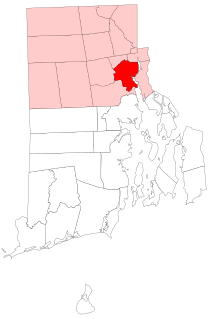
This is a list of the National Register of Historic Places listings in Providence, Rhode Island.

Washington Park Historic District, also known as Washington Square is a historic district in and around Washington Park in the city of Ottawa, Illinois, United States. Washington Park was the site of the first Lincoln-Douglas debates of 1858 and is surrounded by several historic structures. The park was platted in 1831 and the historic district was added to the United States National Register of Historic Places in 1973.

Shreveport Municipal Memorial Auditorium is a historic performance and meeting venue at 705 Elvis Presley Boulevard in Shreveport, Louisiana. It is an Art Deco building constructed between 1926 and 1929 during the administration of Mayor Lee Emmett Thomas as a memorial to the servicemen of World War I. In 1991, the auditorium was listed on the National Register of Historic Places and on October 6, 2008, it was designated a National Historic Landmark.

Old Main is a red-roofed Victorian Gothic building on the campus of Texas State University. Situated at one end of the quad, it was Texas State's first building, built in 1903, and remained the only building on campus until 1908. Old Main was added to the National Register of Historic Places (NRHP) in 1983. It currently houses the offices for the School of Journalism and Mass Communication as well as the College of Fine Arts.

Shofner's Lutheran Chapel is a historic church on Thompson's Creek near Shelbyville, Tennessee, United States. The church and adjacent cemetery are listed on the National Register of Historic Places as Shofners' Lutheran Church and Cemetery.

The Versailles School and Tyson Auditorium is a historic school and auditorium located at Versailles, Ripley County, Indiana. The school was built in 1938, and is a two-story, flat roofed Art Deco style building. The auditorium was added in 1950. James H. Tyson, a founder of Walgreens, funded the buildings. The famous Milan basketball team often played its games in the building, as their home court was often too small for all the spectators.

The Chautauqua Auditorium is a performance hall located in Getzendaner Memorial Park, in Waxahachie, Texas. It was built in 1902 and listed on the National Register of Historic Places on May 3, 1974. The hall seats 2500 and is noted for being an octagonal building. The auditorium hosts performances of the Fort Worth Symphony Orchestra as well as many country music and other shows.
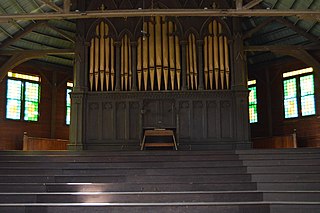
The Davis-Ferris Organ, built in 1847, is the oldest three-manual pipe organ that has escaped significant alteration in the United States. It is located in the Round Lake Auditorium in the village of Round Lake, New York. Originally located in the Calvary Church in Manhattan, it was moved to its present location in 1888, where it was used in Chautauqua-like summer programs into the 1920s. It is now owned and maintained by the village. It was designated a National Historic Landmark in 2016.
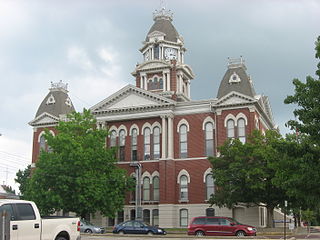
The Shelby County Courthouse is a government building in Shelbyville, the county seat of Shelby County, Illinois, United States. Completed in 1881, it is the third courthouse in the county's history.





















